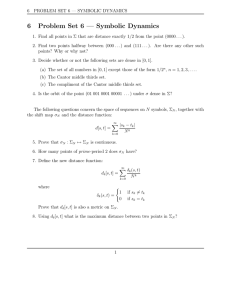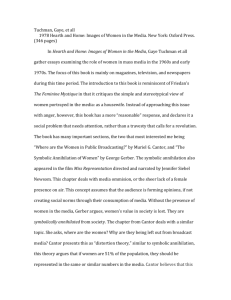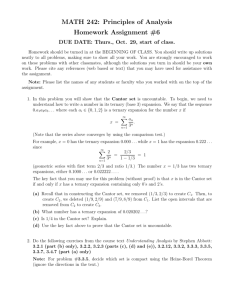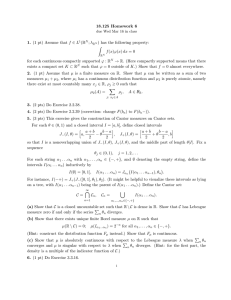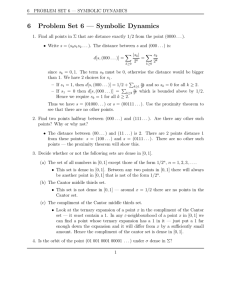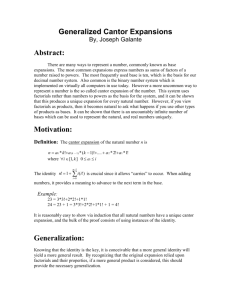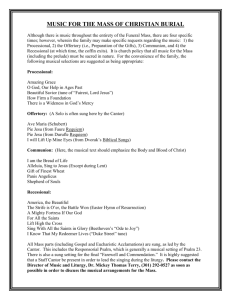Generalized Cantor Expansions 1 Introduction Joseph Galante University of Rochester
advertisement
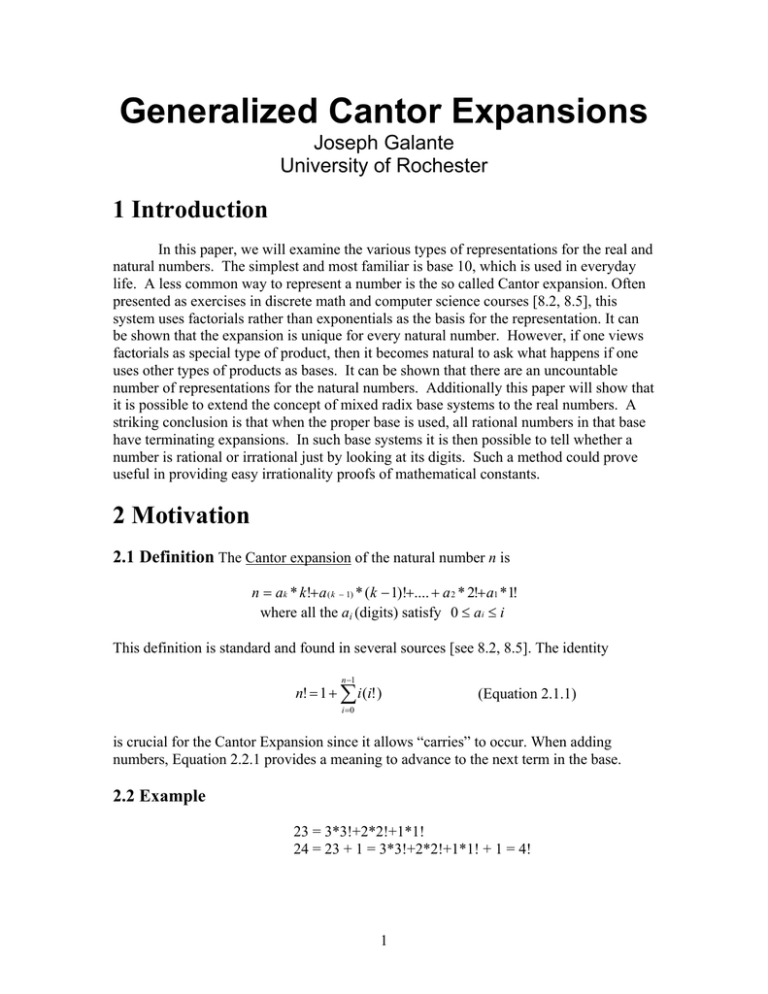
Generalized Cantor Expansions
Joseph Galante
University of Rochester
1 Introduction
In this paper, we will examine the various types of representations for the real and
natural numbers. The simplest and most familiar is base 10, which is used in everyday
life. A less common way to represent a number is the so called Cantor expansion. Often
presented as exercises in discrete math and computer science courses [8.2, 8.5], this
system uses factorials rather than exponentials as the basis for the representation. It can
be shown that the expansion is unique for every natural number. However, if one views
factorials as special type of product, then it becomes natural to ask what happens if one
uses other types of products as bases. It can be shown that there are an uncountable
number of representations for the natural numbers. Additionally this paper will show that
it is possible to extend the concept of mixed radix base systems to the real numbers. A
striking conclusion is that when the proper base is used, all rational numbers in that base
have terminating expansions. In such base systems it is then possible to tell whether a
number is rational or irrational just by looking at its digits. Such a method could prove
useful in providing easy irrationality proofs of mathematical constants.
2 Motivation
2.1 Definition The Cantor expansion of the natural number n is
n = ak * k!+ a ( k − 1) * (k − 1)!+.... + a 2 * 2!+ a1 *1!
where all the ai (digits) satisfy 0 ≤ ai ≤ i
This definition is standard and found in several sources [see 8.2, 8.5]. The identity
n −1
n! = 1 + ∑ i (i! )
(Equation 2.1.1)
i =0
is crucial for the Cantor Expansion since it allows “carries” to occur. When adding
numbers, Equation 2.2.1 provides a meaning to advance to the next term in the base.
2.2 Example
23 = 3*3!+2*2!+1*1!
24 = 23 + 1 = 3*3!+2*2!+1*1! + 1 = 4!
1
It is reasonably easy to show via induction that all natural numbers have a unique Cantor
expansion. Rather than prove uniqueness at this time, we will offer a generalization of
this concept, and then show that the regular Cantor expansion is a special case.
3 Generalization
Knowing that identity 2.1.1 is the key, it is conceivable that a more general identity will
yield a more general result. Realizing that the original expansion relies on factorials and
their properties, a generalization should therefore rely on defining a new and more
general product. Rather than multiplying together the sequence of numbers 1,2,3,4…, we
will consider functions which multiply positive integers in a given list.
3.1 Lemma Let S = {1, x1, x2,…| where xi is a natural number strictly greater than one}.
(Note that the index for the first element will be n=0.) If p(n) is the nth element of S (note
n
p(0)=1) and P( n ) = ∏ p(i ) , then our generalized identity becomes
i =0
n
P( n + 1) = 1 + ∑ ( p(i + 1) − 1) P(i )
(Equation 3.1.1)
i =0
An inductive proof of Lemma 3.1 is presented in section 7.1. Using the generalized
identity we can extend the concept of a Cantor expansion.
3.2 Definition The generalized Cantor expansion (GCE) of the natural number n with
respect to the ordered sequence S is
n = ak * P( k ) + a ( k − 1) * P( k − 1) + .... + a1 * P(1) + a 0 * P(0)
0 ≤ ai < p(i + 1), 0 ≤ i ≤ k
(Equation 3.2.1)
where S, p, and P are as defined above in Lemma 3.1. The sequence S is referred to as
the base set or base sequence. It is important to note that the order of the elements in S
matters, and the ak‘s are called the digits of n in its GCE representation.
Notation varies, but in this paper we will use the format (ak …a0)S where S is the base set
or sometimes just (ak …a0) when the base set is implied. Other notations use matrix
format to combine the digits and base sets [see 8.13]. Lastly, as an example, we often
measure time itself using a limited form of a mixed radix system, which has a base set
corresponding to S={1,60,60,12,...} and has the common format of “hh:mm:ss.”
3.3 Theorem Given a base set S, any natural numbers can be written in generalized
Cantor expansion.
Proof The proof is by induction. It is easy to see that Equation 3.1.1 holds for n=0 and 1.
That is, 0=0*P(0) and 1=1*P(0) since P(0)=1 and p(1)>1.
2
Now assume the first n natural numbers can be written in GCE form. We need to show
that (n+1) can be written this way as well. So we know then that:
n = ak * P( k ) + a ( k − 1) * P( k − 1) + .... + a1 * P(1) + a 0 * P(0) for 0 ≤ ai < p(i + 1), 0 ≤ i ≤ k
where ak is the first nonzero digit of n, so that n ≥ P(k ) . (If the first term was zero, we
could consider a smaller number of terms and re-label subscripts accordingly.) We break
the inductive step up into two cases. See 3.5 for concrete examples of the cases.
Case I: There exists a place i strictly less than k, such that the ith digit ai is strictly less
than p(i+1)-1. This case will cover the addition of one to a number n without any
arithmetic carries into the kth place. We want the number n to have some digit before the
kth place which when one is added to it, will not produce a carry.
Using this idea we see that the digits of n satisfy for some i,
n > ai * P(i ) + .... + a 0 * P(0) = y
The number y will always be strictly less than n since n will always have an additional
nonzero term which y does not, namely the term ak*P(k).
When adding one, the strict inequality, becomes only the inequality
n ≥ ai * P(i ) + .... + a 0 * P(0) + 1
By the inductive hypothesis, we see that there exists a valid generalized Cantor expansion
for y since n≥ y. Thus we can rewrite y+1 as
y +1 = ai * P(i ) + .... + a 0 * P(0) + 1 = ( ai ' ) * P(i ) + .... + ( a 0' ) * P(0)
Our initial assumption about ai will tell us that it will not grow larger than p(i+1)-1 from
a carry and so the rewrite will not require using another place.
It now follows that
n + 1 = ak * P( k ) + .... + ( ai + 1) P(i + 1) + ( ai * P(i ) + .... + a 0 * P(0) + 1)
n + 1 = ak * P( k ) + .... + ( ai + 1) P(i + 1) + ( ai ' ) * P(i ) + .... + ( a 0' ) * P(0)
which is a valid generalized Cantor expansion.
Case II: Digits in all places except the kth place are equal to p(i+1)-1.
This case covers a series of carries that terminates at the greatest digit place of the
number, or possibly advances to the next place.
In this case n = ak * P( k ) + ( p( k ) − 1) * P( k − 1) + .... + ( p(1) − 1) * P(0)
3
Therefore,
n + 1 = ak * P( k ) + ( p( k ) − 1) * P( k − 1) + .... + ( p(1) − 1) * P(0) + 1
= ak * P(k ) + P(k ) from Lemma 3.1
= (ak + 1) * P (k ) + 0 * P (k − 1) + ... + 0 * P(0)
which is a valid generalized Cantor expansion if ak+1< p(k+1)
Otherwise, if ak+1=p(k+1) then
n = ( p( k + 1) − 1) * P( k ) + ( p( k ) − 1) * P( k − 1) + .... + ( p(1) − 1) * P(0)
and
n + 1 = ( p( k + 1) − 1) * P( k ) + ( p( k ) − 1) * P ( k − 1) + .... + ( p(1) − 1) * P(0) + 1
n + 1 = 1 * P ( k + 1) + 0 * P( k ) + .... + 0 * P(0) from Lemma 3.1
which is a valid generalized Cantor expansion.
Therefore by the principle of induction, we can conclude that all natural numbers can be
▄
expressed in a generalized Cantor expansion.
Now that we know every natural number has a generalized Cantor expansion, the
question of uniqueness arises.
3.4 Theorem The generalized Cantor expansion of a natural number is unique.
The proof of this theorem uses induction and is complicated slightly by needing several
different cases. The proof is found in appendix section 7.3 for the curious reader.
3.5 Examples
3.5.1 – Base 10, S={1,10,10,10…}
Example of Case 1
Let n=32378 in regular base 10, and then n+1 = 32378 + 1 = 32379. The addition of the
number one does not produce a carry which changes the digit in the leftmost place. Thus
we can think of n as 30000+2378, and n+1 as 30000+2378+1. In the proof, we used the
inductive hypothesis to argue that 2378 is strictly less than n, and so 2378+1 is less than
or equal to n, and so has a valid expansion, in this case 2379. Then 30000+2379=32379
= n+1 is also valid as an expansion. Our other initial assumption in this case was that
2378 was a number such that 2378+1 would not yield 10000.
Example of Case 2
Let n=39999 and then n+1 = 39999 +1 = 40000. This case uses carries so that when one
is added to the lowest (rightmost) digit, it effects other digits.
Example of Case 2
Let n=99999 and then n+1 = 99999 +1 = 100000. This case uses carries so that when one
is added to the lowest (rightmost) digit, it affects all the other digits and results in n+1
requiring a 6 digit representation.
4
3.5.2 – Mixed Radix, S=set of squares of natural numbers={1,4,9,16,…}
p(0)=1, p(1)=4, p(2)=9
P(0) =1, P(1)=4*1, P(2) = 9*4*1
Example of Case 1
Convert 137 into general Cantor expansion for the given S
137 = 3*P(2) + 7*P(1)+1*P(0) = 3*(9*4*1) + 7*(4*1) + 1*(1)
137 => (3 7 1)S
137+1=138= 3*P(2) + (7*P(1) + 1*P(0)+1)= 3*(9*4*1) + 7*(4*1) + 2*(1)
138 => (3 7 2)S
Example of Case 2
Convert 71 into general Cantor expansion for the given S
71 = 1*P(2) + 8*P(1)+3*P(0) = 1*(9*4*1) + 8*(4*1) + 3*(1)
71 => (1 8 3)S
71 + 1 = 72 = 2*P(2) + 0*P(1) + 0*P(0) = 2*(9*4*1)
72 => (2 0 0)S
Case 2 used:
Convert 575 into general Cantor expansion for the given S
575 = 15*P(2) + 8*P(1)+3*P(0) = 15*(9*4*1) + 8*(4*1) + 3*(1)
575 => (15 8 3)S
575 + 1 = 576 = 1*P(3) + 0*P(2) + 0*P(1) + 0*P(0) = 1*(16*9*4*1)
576 => (1 0 0 0)S
These examples additionally illuminate the fact that some representations using GCE
need not cover every possible combination of digits used. We note that if we start
counting upwards using the base set in example 3.5.2, our representations leap from (1 8
3)S to (2 0 0)S . Thus the range of digits from (1 8 4)S to (1 9 9)S is off limits since it
breaks the rules of our representation. If we choose to break the rules, then we lose
uniqueness of representations.
It is interesting to consider the cardinality of the set of all possible generalized Cantor
expansions.
3.6 Theorem There are an uncountable number of base sets S which can be used to
make generalized Cantor expansions.
Proof
Each expansion has a unique base set S which characterizes the expansion.
5
S = {1, x1, x 2,... | where xi > 1, xi a natural number}
We can construct another base set S’ with a smaller range of terms such that
S ' = {1, x1 mod 10, x 2 mod 10,... | where xi ∈ S}
There is a one to one correspondence between the elements of S’ and the digits of a real
number y = 1. y1 y 2 y 3.... (standard notion of base 10 representation for real numbers is
used here).
Since every value of every variable will be reached if we consider the set of all S’s, then
every real number on the continuous interval [1,2) will be reached via its decimal
expansion. Thus the cardinality of the set of all S’ is the same as that of the real numbers,
and thus is uncountable. The set of all S, which is a larger set, is also then uncountable.
Therefore there are an uncountable number of base sets S which can be used to make
▄
generalized Cantor expansions.
Now with powerful new facts about generalized Cantor expansions, we can examine how
specific number systems fit into this definition. For example, we will show how the
Cantor expansion and also our regular base 10 number system fit into the picture.
3.7 Factorials and the Cantor Expansion
To see how the original Cantor expansion is a special case of the GCE, let
S = {1,2,3,4,5….}. It easily follows that p(i) = i+1 and P(i) = (i+1)!
Identity 2.1.1 becomes
n −1
n −1
n
n
i =0
i =0
i =1
i =0
1 + ∑ ( p (i + 1) − 1) * P(i ) = 1 + ∑ (i + 1)(i + 1)! = 1 + ∑ i * (i! ) = 1 + ∑ i * (i! ) = (n+1)!
which, is actually the original identity shifted up by one iteration. Then
n = ak*P(k ) +…a1*P(1) + a0*P(0)
= ak*(k+1)! +…a1*2! + a0*1!
Where 0 ≤ ai ≤ i+1. The more natural notation in this example would be to let ai be
associated with i! Therefore shifting indices yields
Where 0 ≤ ai ≤ i.
ak+1*(k+1)! +…a1*2! + a1*1!
Proof of the factorial identity (Equation 2.2.1) is an exercise in [8.2].
3.8 Base-b
6
In general, base-b numbers can be represented using S = {1,b,b,b,….} for b>1, b a natural
number. It follows that p(0)=1, p(i) = b for i>0, and P(i) = bi.
This reduces equation 3.1.1 to
n
P( n + 1) = 1 + ∑ (b − 1) * b i = b ( n +1)
(Equation 3.8.1)
i =0
Additionally the coefficients will be between 0 ≤ ai ≤ (b - 1) and
n = ak * b k + a ( k − 1) * b ( k −1) + ... + a 0
which is the standard definition of a number in base-b notation
(Proof of equation 3.8.1 is an example in [8.2])
3.9 Other Interesting Examples of Mixed Radix
There are several other interesting cases to consider for the base set S.
Letting S = {1,2,3,5,7,11,13...( primes of increasing order )...}
The consecutive products become what are known as primorials. (See [8.11] for an
overview of the properties of primorials.) By picking this base set, we can write numbers
as sums of primorials.
17 = 2*(3*2*1) + 2*(2*1) + 1*(1) => (2 2 1)S
42 = 1*(5*3*2*1) + 2*(3*2*1)+0*(2*1)+0*(1) => (1 2 0 0) S
We can also go the other direction and note that certain prime numbers have nice sums
attached to them.
(1 0 0 0 0 0 0 0 0 0 0 1) S =>
1*(31*29*23*19*17*13*11*7*5*3*2*1) + 1*1=200560490131 which is prime
(9 8 7 6 5 4 3 2 1) S => 9*(19*17*13*11*7*5*3*2*1) +
8*(17*13*11*7*5*3*2*1)+7*(13*11*7*5*3*2*1)+6*(11*7*5*3*2*1)+5*(7*5*3*2*1)+
4*(5*3*2*1)+3*(3*2*1)+2*(2*1)+1*(1) = 91606553 which is prime
4 The Leap to The Reals
Having considered several cases with the natural numbers, it becomes logical to question
whether Generalized Cantor Expansions can be extended to the real numbers.
4.1 The New Identity
7
Let S be a sequence of natural numbers where the first element is one and all other
elements are greater than one. (Note that the index for the first element will be n=0.)
n
Define p(n) = the nth element of S (note p(0)=1) and P( n ) = 1 /[∏ p(i )] .
i =0
Our generalized identity then is
n
1 = ∑ ( ( p(i ) − 1) * P(i ) ) + P( n )
(Equation 4.1.1)
i =0
An inductive proof of 4.1.1 can be found in section 7.2. With 4.1.1, which in some
respects is similar to 3.1.1 for natural numbers, we can create a new definition.
4.2 Definition
A number x, 0≤x<1 can be represented in a Fractional Generalized Cantor Expansion
(FGCE) with respect to the base set S if and only if
∞
x = c1 * P(1) + c 2 * P( 2) + ... = ∑ ( ci * P(i ))
(Equation 4.2.1)
i =1
where 0≤ci<p(i), with p, P, and S as defined in 4.1. The sequence S is referred to as the
base set or base sequence. It is important to note that the order of the elements in S
matters, and the ci‘s are called the digits of n in its FGCE representation.
We can write in short hand x=( . c1 c2 c3 ….)S
It would be nice if all FGCE’s converge so that our definition is well defined, but first we
must know some of the properties of the function P.
4.3 Lemma P converges to zero as n approaches infinity.
Proof
Since xi ≥ 2 for all i≥1, then
1
0<P(n) = ---------------- ≤
x1*x2*...*xn
1
----------- = (1/2)n for all n
2*2*...*2
As n approaches infinity, (1/2)n approaches zero, and thus P converges to zero by the
▄
squeeze theorem.
With this nice property of P, we can continue.
4.4 Theorem For a given base set S, all FGCE series are convergent.
8
Proof
If we use ci=p(i)-1 for each i , then Equation 4.1.1 becomes
n
1 = ∑ ( ( p(i ) − 1) * P(i ) ) + P( n )
i =1
and it follows that
n
1 > ∑ ( ( p(i ) − 1) * P(i ) ) ≥ 0
i =1
Thus the largest FGCE is bounded for any n. We then have
n
0 ≤ (1 − ∑ ( ( p(i ) − 1) * P (i ) ) ) = P (n)
i =1
which converges by Lemma 4.3. Thus the sum converges as well.
We then note that
n
n
i =1
i =1
0 ≤ ∑ ( ci * P(i ))) ≤ ∑ ( ( p(i ) − 1) * P(i ))
since all coefficients ci are satisfy 0≤ ci ≤p(i)-1, and we have convergence of the smaller
sum by the comparison test.
Therefore all FGCE series converge.
▄
4.5 Definition A terminating FGCE of length n is an FGCE that contains only a finite
number of nonzero terms such that all the nonzero terms occur before the n+1 term, for
some nonnegative integer n.
Example In base 10, 0.1742 would have a terminating FGCE of length 4, since all the
nonzero terms occur before the 5th place. (The initial 0. does not count as a place.)
Example In base 10, 1/3=0.3333333… would not have a terminating FGCE.
4.6 Lemma Terminating FGCE’s of length n divide the interval [0,1) up into
increments of P(n) for a given n and given base set S.
Proof
In this proof, we will be using both the GCE and FGCE, so we will denote the GCE base
set as S’ and the GCE P and p functions as P’ and p’.
Let S={1, x1, x2 ,….,xn} ( We do not care about terms after xn )
Let S’={1, xn, x(n-1) ,….,x1}.
The reason for the strange indexing becomes apparent later, but note that P(n)=P’(n).
9
Let l = m/P(n), where 0≤m≤P(n)-1. We can see that as m varies between 0 and
P(n)-1, that the l’s divide up [0,1) into increments of length P(n).
We now want to write m as a GCE
m = cn + cn-1 (xn)+ cn-2 (xn *xn-1)+ … + c2 (xn*…*x4*x3 ) + c1 (xn*…*x3*x2)
With 0≤ ci< p’(i+1) (Note that we are counting down from n with our ci’s so from
definition 3.2 ak=cn-k ) Also we omit the term c0 since it is zero, as m<P’(n)= x1*x2*...*xn
So l = m/P(n) = m/( x1*x2*...*xn)
After some shuffling of terms, we get
c1 x2*x3*...*xn c2 x3*x4*…*xn
cn
l= ----------------- + ------------------ +….+ ---------------x1*x2*...*xn
x1*x2*...*xn
x1*x2*...*xn
After simplification of the fractions, we get
c1
c2
cn
l= --- + ------ +….+ ---------------x1 x1*x2
x1*x2*...*xn
So,
n
l = ∑ ( ci * P(i )) =c1 * P (1) + ... + cn * P( n )
i =1
At this point, we notice that the number l has been put into a terminating FGCE of length
n since the coefficients satisfy 0≤ ci< p’(i+1) = xi = p(i). So the l’s, which are rational
numbers represented by terminating FGCE’s, divide up the interval [0,1) into increments
▄
of length P(n).
Next we show that each real number has a FGCE associated with it. The following
theorem extends the concept of a Generalized Cantor Expansion to the real numbers in
the unit interval [0,1). Once the numbers in [0,1) have FGCEs then it is relatively easy to
extend the concept to all real numbers.
4.7 Theorem For a given base set S, each real number 0≤x<1 has a FGCE
Proof
This figure nicely illustrates the process which we will be employing.
Figure 4.7.1 - P’s dividing up [0,1) with an x in between (S={1,2,3,5…} shown)
10
We notice that for a given x, and a fixed n, we can pick ci’s so that
c1*P(1)+c2*P(2)+…+cn*P(n) ≤ x ≤ c1*P(1)+c2*P(2)+…+(cn+1)*P(n) (Eqn. 4.7.2)
We pick the ci’s (digits) so that x’s location in [0,1) can be specified within an interval of
length P(n). The coefficients determine the start and end points of this interval.
Additionally, we want as tight a bound on x as possible with our choices. To do this, it is
easiest to think of the process of picking the digits as an algorithm where you pick the
largest c1 available under the FGCE definition to satisfy c1*P(1) ≤ x ≤ (c1+1)*P(1), then
pick the largest c2 available to satisfy c1*P(1)+c2*P(2)≤ x ≤ c1*P(1)+(c2+1)*P(2), and so
on, each time keeping the ci’s from the previous step. You can keep doing this procedure
indefinitely to obtain as many digits of x as desired.
( As an example, in figure 4.7.1 with S={1,2,3,5…},
for n=1, c1=1 since 1*P(1) ≤ x≤ (1+1)*P(1),
for n=2, c1=1 and c2=0 since 1*P(1)+0*P(2) ≤ x ≤ 1*P(1)+(0+1)*P(1),
for n=3, c1=1, c2=0, and c3=2 ,
since 1*P(1)+0*P(2)+2*P(3)≤ x ≤ 1*P(1)+0*P(1)+(2+1)*P(3).
In base 10, this procedure would be equivalent to saying 0.5≤x<1, 0.50≤x≤0.66,
0.566≤x≤0.600,… )
Our goal is to have the ci’s (digits) we just picked form a convergent series which goes to
x as we add more digits. Rewriting equation 4.7.2, we see that our choice of ci’s for
given n’s actually results in partial sums of an FGCE. So for a given S, and an x in the
interval [0,1), we have picked an n and ci’s (digits) that satisfies, for x a real number:
n
n
i =1
i =1
∑ (ci * P(i )) ≤ x ≤ ∑ (ci * P(i )) + P(n)
Then,
n
0 ≤ x − ∑ ( ci * P(i )) ≤ P( n )
i =1
n
As n approaches infinity, x − ∑ ( ci * P(i )) is squeezed in between zero and P(n), which
i =1
n
is known to converge to zero from lemma 4.3. So, x − ∑ ( ci * P(i )) approaches zero as n
i =1
11
n
approaches infinity, which is to say that
∑ (c * P(i )) approaches x as n approaches
i
i =1
infinity. Thus for the given x, there is an FGCE series which converges to x.
▄
Unlike the natural number expansions, we cannot show that FGCE’s for a given x and S
are unique. Since FGCE’s for real numbers are infinite series, they may have different
coefficients, provided that they converge to x. All that is needed is that the expansions
agree enough so that the difference between the expansion and x is arbitrarily small. For
example in decimal, 1=0.9999999999999… This is the only type of non-uniqueness
found using the real numbers.
As a useful convention, we can define the Proper Fractional Generalized Cantor
Expansion of a real number x as the terminating expansion which is exactly equal to x.
The proper FCGE may not exist for some numbers, since the number may have an
infinite number of digits in the expansion to begin with, regardless of the base set S. For
example in decimal (S={1,10,10,10…}), the number π would not have a proper FGCE
since there is no finite sum of fractions which will equal π exactly.
4.8 Example – Proper FGCE
Let S={1,2,2,2,2…} which corresponds to the binary number system
Then we have 1/2= ( . 1,0,0,0….)S or 1/2=( . 0,1,1,1,1…) S
In this case ( . 1,0,0,0….)S is the proper expansion since after one term, the expansion
when evaluated, will give back the exact number it is meant to represent.
In regular decimal notation,
1.0000… is a proper FGCE for one, as opposed to 0.9999999…
Armed with the definition of a proper FGCE, we can notice that these expansions
produce some very interesting properties with rational numbers. Here are some examples
of expansions of both rational and irrational numbers to help guide us.
4.9 Example - FGCE Expansions
Consider the base set S = {1,2,3,4,5…}
∞
e-2=(1 1 1 1..) S which is expected since e = ∑1 / k!
k =0
Log(2) = (1 1 0 3 1 0 3 6 2 5 4 6 11..) S (pattern not apparent)
24/25 = (1 2 3 0 1 1 3 1 8 0 0 0 0..) S
1/7 = (0 0 3 2 0 6 0 0 0 0..) S
12
In base-10, different fractions have different periods. If the fraction contain only powers
of 2 and 5 in the denominator, it will terminate. Otherwise it will repeat and its digits
will form cycles. (See [8.4] for more about the decimal cycles of fractions.) It is also
known that in other bases, different fractions terminate than those of base 10. For
example in base 3, 1/3 has a terminating expansion, whereas 1/2 will have a repeating
expansion. In fact in base 3, all fractions which have only powers of 3 in the
denominator will have terminating expansions. It is interesting to look at Fractional
Generalized Cantor Expansions which could have all powers of all primes in the base set.
Then all fractions will have terminating expansions. The following theorem will show
this.
4.10 Theorem Given a base set S and a rational number x=a/b with 0≤x<1, x has a
proper FGCE if and only if there exists an i such that b divides x1*x2*...*xi .
Proof
We take x=a/b with a and b in reduced form, so that a and b are relatively prime.
(Forward Direction)
Assume that x has a proper FGCE.
Then
a
c1 c2
ci
x= - = -- + ------ +…. +------------b
x1 x1*x2
x1*x2*...*xi
By simply putting all the fractions in common denominator form and adding them, we
get
a
t
x = -- = -------------- < 1
b x1*x2*...*xi
If t / ( x1*x2*...*xi) is in reduced form, then a=t and b=( x1*x2*...*xi), and so b divides
x1*x2*...*xi, since b divides itself.
If t / ( x1*x2*...*xi) is not in reduced form, then both t and ( x1*x2*...*xi) have some
common factor c > 1. If we divide both t and ( x1*x2*...*xi) by this common factor, then
(t/c) and (( x1*x2*...*xi)/c) become relatively prime. But then this would mean that a=t/c
and b=(( x1*x2*...*xi)/c).
b=(( x1*x2*...*xi)/c) and so b*c =( x1*x2*...*xi) which implies b divides ( x1*x2*...*xi)
In either situation b divides x1*x2*...*xi.
(Reverse Direction)
13
Assume there exists an i such that b divides x1*x2*...*xi
Then b*d= x1*x2*...*xi for some d.
So,
a a*d
a*d
- = ----- = -------------- < 1
b b*d
x1*x2*...*xi
By lemma 4.5, a FGCE divides the unit interval up into fractions with denominators of
P(i) = x1*x2*...*xi for a given i, and a/b is a fraction of such a form. Therefore a/b has a
▄
finite, terminating expansion of length i, and thus it has proper FGCE.
A necessary condition for S to give a specific fraction a terminating expansion is that it
contains the factors of the denominator of x. Thus an appropriate choice of S to make all
rational numbers have terminating expansions would be an S in which all possible factors
are included. Once we have selected such a base set, theorem 4.10 holds for all rational
numbers.
This is an interesting result since it implies that there could be base set in which all
rational numbers between zero and one have a terminating expansion. We present such a
base set now. Consider S ={1,2,3,4,5…}. In this base set, there is always an i such that b
divides x1*x2*...*xi. This is so since all natural numbers are contained in the set and we
can pick the i such that xi = i =b. Then b divides x1*x2*...*xi, since b divides x1*x2*...*b.
And so this base has the remarkable property of making the separation of rational and
irrational numbers apparent by their numerical representations. If we have a number
whose irrationality we are not sure of, we can expand it out in with our special base set
and if it terminates it must be rational. Conversely if we can prove that its representation
will require an infinite number of nonzero digits with this base set, then it must be
irrational.
Another interesting property of the base set S ={1,2,3,4,5…} is its expansion of e-2=(1 1
1 1..) S . Using this set, irrational numbers may exhibit patterns in their infinite length
expansions similar to the way some rational numbers do in bases without mixed radixes
(ex. in base 10, 1/9 = 0.1111…). The argument in Theorem 3.6 can be used again on the
base sets for FGCE’s, so we know there are an uncountable number of base sets to
choose from. It would be interesting for someone to examine these types of patterns
further and look for other patterns in other base sets which meet the requirements for
Theorem 4.10. Are there an infinite number of these types of base sets and do they all
produce patterns with irrational numbers? I leave it to the curious reader to explore this
further.
Finally, we realize that every real number consists of an integer and “decimal” part. The
GCE allows all the integer parts to be represented, and the FGCE allows all “decimal”
parts to be represented. Thus the expansion of a real number can be thought of as a list of
14
coefficients for the GCE and FGCE with respect to two base sets. We can write for a real
number
x=( an … a2 a1 . c1 c2 c3 ….)S, S’
with the S and numbers to the left of the decimal point representing a GCE and the S’ and
numbers to the right of the decimal point representing a FGCE. Since there are an
uncountable number of valid choices for both base sets, then there are an uncountable
number of ways to represent the real numbers.
4.11 Example
If S = S’ = {1,2,3,5,7…primes of increasing order}, then
ππ = 36 + 0.46215960…
= ( 1 1 0 0 . 0 2 3 6 0 7 11 1 21 4 28 ….)S, S’ (no apparent pattern).
5 Conclusion
Having taken a brief excursion into the world of numerical representations, we recall that
some representation methods are common day, such as decimal, others are more exotic,
such as the Cantor base expansion, and still others have many practical applications, such
as binary. By extending our definition of base to a mixed radix system, the Generalized
Cantor Expansion gives us an uncountable number of systems to represent the natural and
real numbers. Additionally we have seen that by picking our representations carefully we
can have special types of bases where is it easy to identify rational and irrational numbers
by their expansions and that these bases may have other rich properties as well.
But the question now becomes “how general can we make our representations?” Donald
Knuth [8.9] said that “π is 10 in base π”. Perhaps the generalized representations
presented here can be extended further to include rational and real numbers into the base
sets. There are instances of using the golden ratio as a base [8.14] as well as negative
numbers [see 8.15]. All of these representations could be very useful in digit related
number theory. Now that we have shown that there are bases in which all rational
numbers have terminating expansions, we can extend previously discrete and finite
methods to include rational numbers. For example, the concepts of additive persistence
and digital roots normally use base 10 numbers, however, now since it has been shown
there are an uncountable number of bases to pick from, those concepts can be expanded
[see 8.8, 8.10]. Such may be true of much in the field of digit related number theory.
6 Thanks
Special thanks to Ken McMurdy for constructive feedback, comments, and support that
helped make this paper possible. Thanks to Will Jennings and George Bruhn for proof
15
reading this paper and providing constructive feedback. Thanks to the referees for
providing many helpful suggestions.
7 Appendix
This appendix contains proofs of lemmas and theorems left out of the main body. The
proofs are of an uninteresting character, but are presented to be thorough.
7.1 – Proof of Lemma 3.1
We proceed by induction on n.
Basis: n=0
p(1)=p(1)
p(1)*1=p(1)-1 +1
P(1) = 1 + (p(1)-1)*1 since P(1)=1*p(1)
P(0+1) = 1 + (p(0+1)-1)*P(0) since P(0)=p(0)=1
Thus the basis case is established
We assume that equation 3.1.1 works for the first n natural numbers, then we need to
show it works for n+1 as well.
P( (n+1) +1 ) = P(n+2) = p(n+2)*P(n+1) ( from definition of P(n) )
= (p(n+2)-1)*P(n+1) + P(n+1)
n
= (p(n+2)-1)*P(n+1) + ( 1 + ∑ ( p(i + 1) − 1) P (i ) ) ( By the Inductive Hypothesis )
i =0
n +1
P( n + 2) = 1 + ∑ ( p(i + 1) − 1) P(i )
i =0
Therefore by the principle of induction,
n
P( n + 1) = 1 + ∑ ( p(i + 1) − 1) P(i )
Holds for all natural numbers n.
▄
i =0
7.2 – Proof of Lemma 4.1
We proceed by induction on n.
Basis:
n=0
1=0*1+1=(1-1)*1+1=(p(0)-1)*P(0) + P(0)
n=1
1=p(1)/p(1)
1=(p(1)-1)/p(1) + 1/p(1)
and since P(1) =1/(p(1)*p(0))=1/(p(1)*1) = 1/p(1) and (p(0)-1)*P(1) =0
16
1= ( (p(0)-1)*P(0) + (p(1)-1)*P(1) ) + P(1)
Thus the basis case has been established.
We assume equation 4.1.1 is true for n and we need to show it is true for (n+1).
n +1
1 = ∑ ( ( p(i ) − 1) * P (i ) ) + P( n + 1)
i =0
n
1 = ∑ ( ( p(i ) − 1) * P(i ) ) + ( p( n + 1) - 1) P( n + 1) + P( n + 1)
i =0
n
1 = ∑ ( ( p(i ) − 1) * P(i ) ) + p( n + 1) P( n + 1)
i =0
n
1 = ∑ ( ( p(i ) − 1) * P (i ) ) + p( n + 1) * ( P( n ) / p( n + 1))
i =0
n
1 = ∑ ( ( p(i ) − 1) * P(i ) ) + P( n )
i =0
which by the inductive hypothesis is assumed to be true.
Therefore the identity is true for all n≥1.
▄
7.3 – Proof of Theorem 3.4
We proceed by induction on n, the number of digits.
As a basis case, we first note that all single digit GCE’s have a unique expansion. So if
n1=a0 and n1=b0 are less than P(1), then a0=b0. In a sense we consider single digits as
the building blocks of all representations.
Now we will consider n≥P(1), and suppose that all numbers with k-1 digit representations
have unique representations. We need to show that all k digit numbers have unique
representations.
Suppose n has two k-digit representations.
n = ak * P( k ) + a ( k − 1) * P( k − 1) + .... + a1 * P(1) + a 0 * P(0) and
n = ( ak )'*P( k ) + ( a ( k − 1))'*P ( k − 1) + .... + ( a1)'*P(1) + ( a 0)'*P(0)
Let m = ak * P( k ) and r = a ( k − 1) * P( k − 1) + .... + a1 * P(1) + a 0 * P(0)
Let m’ = ( ak )'*P( k ) and r’ = ( a ( k − 1))'*P( k − 1) + .... + ( a1)'*P(1) + ( a 0)'*P(0)
So n=m+r and n=m’+r’. Then n-n = 0 = (m-m’)+(r-r’)
Then abs(m-m’)=c*P(k) and abs(r-r’) < P(k)
17
Case I: m-m’>0 and r-r’>0
Then (m-m’)+(r-r’) > 0, which is a contradiction.
Case II: m-m’>0 and r-r’ < 0
Then (m-m’)+(r-r’) ≥ 1*P(k) + r-r’ > 1*P(k) – P(k) = 0
But (m-m’)+(r-r’) > 0 is a contradiction.
Case III: m-m’<0 and r-r’ > 0
Then (m-m’)+(r-r’) ≤ -1*P(k) + r-r’ < -1*P(k) + P(k) = 0
But (m-m’)+(r-r’) < 0 is a contradiction.
Case IV: m-m’<0 and r-r’<0
Then (m-m’)+(r-r’) < 0, which is a contradiction.
So the only possible choice is then for m-m’=0. So then m=m’ and r=r’
Since r=r’ and r has k-1 digit representation, then r has a unique k-1 digit representation.
Thus we conclude a0=a0’…ak-1 = ak-1’. Since m=m’ then ak=ak’. Thus n has a unique
generalized Cantor expansion.
Therefore the generalized Cantor expansion of a natural number is unique.
▄
8 References
8.1 Friedberg, Insel, Spence. Linear Algebra. Third Edition. Prentice Hall. New Jersey
ISBN 0-13-233859-9
8.2 Johnsonbaugh, Richard. Discrete Mathematics. Second Edition. Macmillan
Publishing Company. New York. ISBN 0-02-359690-2
8.3 Lady, E.L. “The Cantor Expansion of a Number.”
http://www.math.hawaii.edu/~lee/discrete/Cantor.pdf
8.4 Ore, Oystein. Number Theory and Its History. Dover Publications. Inc. New York.
ISBN 0-486-65620-9
8.5 Rosen, Kenneth H. Discrete Mathematics. Fourth Edition. McGraw Hill.
ISBN 0-07-289905-0
8.6 Sidorov, Nikita and P. Glendinning. Unique representations of real numbers in noninteger bases Math. Res. Letters 8 (2001), 535-543.
8.7 Spivak, Michael. Calculus. Third Edition. Publish or Perish Inc.
ISBN 0-914098-89-6
18
8.8 Weisstein, Eric. MathWorld. “Additive Persistence”
http://mathworld.wolfram.com/AdditivePersistence.html
8.9 Weisstein, Eric. MathWorld. “Base.” http://mathworld.wolfram.com/Base.html
Note: The reference to Knuth was taken off of this site, which in turn got the
reference from Knuth’s Book:
Knuth, D. E. "Positional Number Systems." §4.1 in The Art of Computer
Programming, Vol. 2: Seminumerical Algorithms, 3rd ed. Reading, MA: AddisonWesley, pp. 195-213, 1998
8.10 Weisstein, Eric. MathWorld. “Digital Root”
http://mathworld.wolfram.com/DigitalRoot.html
8.11 Weisstein, Eric. MathWorld. “Primorial”
http://mathworld.wolfram.com/Primorial.html
8.12 Wikipedia. “Dedekind Cut” http://www.wikipedia.org/wiki/Dedekind_cut
8.13 Wikipedia. “Mixed Radix” http://en2.wikipedia.org/wiki/Mixed_radix
8.14 Wikipedia “Golden Mean Base” http://en2.wikipedia.org/wiki/Golden_mean_base
8.15 Wikipedia “Numeral Systems” http://en.wikipedia.org/wiki/Numeral_system
19
